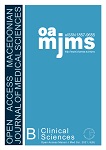The Outcomes of Transcatheter Closure in Patients with Patent Ductus Arteriosus at Haji Adam Malik General Hospital, Indonesia
DOI:
https://doi.org/10.3889/oamjms.2021.5764Keywords:
Patent ductus arteriousus, transcatheter closure, OutcomesAbstract
BACKGROUND: Patent ductus arteriosus (PDA) is one of the most common acyanotic congenital heart diseases. The incidence of PDA is approximately 1 in 500 full-term neonates. The current management of PDA includes pharmacological and surgical treatments. Transcatheter closure is a preferable PDA treatment than pharmacological intervention, for medications have a higher failure rate in premature infants. Several studies have reported the efficacy and safety of transcatheter closure in smaller and lower-weight infants.
AIM: This study aims to describe the outcomes of transcatheter closure of PDA, which are complete closure, migrating device, and residuals, while also investigating factors that might affect these outcomes.
METHODS: A descriptive cross-sectional study was conducted from January to March 2018 in the pediatric cardiology outpatient clinic of Haji Adam Malik Hospital, Medan, Indonesia. All PDA patients who underwent transcatheter closure were included in this study. We collected patients’ demographic data (age and sex), PDA size (categorize into large, moderate, and small), and PDA closure outcomes from medical records. The collected data were then analyzed with SPSS.
RESULTS: One hundred and two children were included in this study, comprised 34 (33.3%) males and 68 (66.7%) females, with a mean age of 4.3 (±4.02) years old and the mean size of the defects 4.4 (±2.25) mm. Transcatheter closure with Lifetech® PDA Occluder was performed in 95 (93.1%) and MFO® in 7 (6.9%) patients. Small residuals were found in three patients, device migration was found in one patient. No relationship was found between the size of PDA and the outcomes measured.
CONCLUSION: We concluded that transcatheter closure remains an effective treatment for PDA, with a considerable success rate.
Downloads
Metrics
Plum Analytics Artifact Widget Block
References
Gupta SK, Krishnamoorthy KM, Tharakan JA, Sivasankaran S, Sanjay G, Bijulal S, et al. Percutaneous closure of patent ductus arteriosus in children: Immediate and short-term changes in left ventricular systolic and diastolic function. Ann Pediatr Cardiol. 2011;4(2):139-44. https://doi.org/10.4103/0974-2069.84652 PMid:21976873 DOI: https://doi.org/10.4103/0974-2069.84652
Behjati-Ardakani M, Behjati-Ardakani MA, Hosseini SH, Noori N. Long-term results of transcatheter closure of Patent ductus arteriosus in infants using Amplatzer duct occluder. Iran J Pediatr. 2013;23(4):411-6. https://doi.org/10.4103/1947-2714.157478 PMid:24427494 DOI: https://doi.org/10.4103/1947-2714.157478
Morville P, Akhavi A. Transcatheter closure of hemodynamic significant patent ductus arteriosus in 32 premature infants by Amplatzer ductal occluder additional size-ADOIIAS. Catheter Cardiovasc Interv. 2017;90(4):612-7. https://doi.org/10.1002/ccd.27091 PMid:28471089 DOI: https://doi.org/10.1002/ccd.27091
Saliba Z, El-Rassi I, Helou D, Abou-Jaoudeh P, Chehab G, Daou L, et al. Development of catheter-based treatment of patent ductus arteriosus: A medium-sized centre experience. Arch Cardiovas Dis. 2009;102(2):111-8. https://doi.org/10.1016/j.acvd.2008.11.001 PMid:19303578 DOI: https://doi.org/10.1016/j.acvd.2008.11.001
Moore JW, Levi DS, Moore SD, Schneider DJ, Berdjis F. Interventional treatment of patent ductus arteriosus in 2004. Catheter Cardiovasc Interv. 2005;64(1):91-101. https://doi.org/10.1002/ccd.20243 PMid:15619281 DOI: https://doi.org/10.1002/ccd.20243
Morgan G, Tometzki AJ, Martin RP. Transcatheter closure of long tubular patent arterial ducts: The Amplatzer duct occluder II-a new and valuable tool. Catheter Cardiovasc Interv. 2009;73(4):576-80. https://doi.org/10.1002/ccd.21841 PMid:19235246 DOI: https://doi.org/10.1002/ccd.21841
Thanopoulos B, Eleftherakis N, Tzannos K, Stefanadis C. Transcatheter closure of the patent ductus arteriosus using the new Amplatzer duct occluder: Initial clinical applications in children. Am Heart J. 2008;156(5):917.e1-6. https://doi.org/10.1016/j.ahj.2008.08.001 PMid:19061707 DOI: https://doi.org/10.1016/j.ahj.2008.08.001
Forsey J, Kenny D, Morgan G, Hayes A, Turner M, Tometzki A, et al. Early clinical experience with the new Amplatzer ductal occluder II for closure of the persistent arterial duct. Catheter Cardiovasc Interv. 2009;74(4):615-23. https://doi.org/10.1002/ccd.22055 PMid:19360878 DOI: https://doi.org/10.1002/ccd.22055
Bass JL, Wilson N. Transcatheter occlusion of the patent ductus arteriosus in infants: Experimental testing of a new Amplatzer device. Catheter Cardiovasc Interv. 2014;83(2):250-5. https://doi.org/10.1002/ccd.22931 PMid:24446324 DOI: https://doi.org/10.1002/ccd.22931
Park YA, Kim NK, Park SJ, Yun BS, Choi JY, Sul JH. Clinical outcome of transcatheter closure of patent ductus arteriosus in small children weighing 10 kg or less. Korean J Pediatr. 2010;53(12):1012-7. https://doi.org/10.3345/kjp.2010.53.12.1012 PMid:21253316 DOI: https://doi.org/10.3345/kjp.2010.53.12.1012
Dimas VV, Takao C, Ing FF, Mattamal R, Nugent AW, Grifka RG, et al. Outcomes of transcatheter occlusion of patent ductus arteriosus in infants weighing ≤6 kg. JACC Cardiovasc Interv. 2010;3(12):1295-9. https://doi.org/10.1016/j.jcin.2010.08.022 DOI: https://doi.org/10.1016/j.jcin.2010.08.022
Gruenstein DH, Ebeid M, Radtke W, Moore P, Holzer R, Justino H. Transcatheter closure of patent ductus arteriosus using the AMPLATZERTM duct occluder II (ADO II). Catheter Cardiovasc Interv. 2017;89(6):1118-28. https://doi.org/10.1002/ccd.26968 DOI: https://doi.org/10.1002/ccd.26968
Mandhan P, Brown S, Kukkady A, Samarakkody U. Surgical closure of patent ductus arteriosus in preterm low birth weight infants. Congenit Heart Dis. 2009;4(1):34-7. https://doi.org/10.1111/j.1747-0803.2008.00241.x PMid:19207401 DOI: https://doi.org/10.1111/j.1747-0803.2008.00241.x
Schneider DJ, Moore JW. Patent ductus arteriosus. Circulation. 2006;114(17):1873-82. PMid:17060397 DOI: https://doi.org/10.1161/CIRCULATIONAHA.105.592063
Yarrabolu TR, Rao PS. Transcatheter closure of patent ductus arteriosus. Pediatr Ther. 2012;S5:1-8. https://doi.org/10.4172/2161-0665.s5-005 DOI: https://doi.org/10.4172/2161-0665.S5-005
Tharakan J, Venkateshwaran S. Large patent ductus arteriosus: To close or not to close. Ann Pediatr Cardiol. 2012;5(2):141-4. https://doi.org/10.4103/0974-2069.99615 PMid:23129902 DOI: https://doi.org/10.4103/0974-2069.99615
Saliba Z, El-Rassi IS, Abi-Warde MT, Chehab G, Daou L, Khater D, et al. The Amplatzer duct occluder II: A new device for percutaneous ductus arteriosus closure. J Interv Cardiol. 2009;22(6):496-502. https://doi.org/10.1111/j.1540-8183.2009.00504.x PMid:19780890 DOI: https://doi.org/10.1111/j.1540-8183.2009.00504.x
Parra-Bravo R, Cruz-Ramírez A, Rebolledo-Pineda V, Robles- Cervantes J, Chávez-Fernández A, Beirana-Palencia L, et al. Transcatheter closure of patent ductus arteriosus using the amplatzer duct occluder in infants under 1 year of age. Rev Esp Cardiol. 2009;62:867-74. https://doi.org/10.1016/s1885-5857(09)72651-9 PMid:19706242 DOI: https://doi.org/10.1016/S1885-5857(09)72651-9
Choi DY, Kim NY, Jung MJ, Kim SH. The results of transcatheter occlusion of patent ductus arteriosus: Success rate and complications over 12 years in a single center. Korean Circ J. 2010;40(5):230-4. https://doi.org/10.4070/kcj.2010.40.5.230 PMid:20514333 DOI: https://doi.org/10.4070/kcj.2010.40.5.230
Hajizeinali A, Sadeghian H, Rezvanfard M, Alidoosti M, Kassaian SE, Nematipour E. Transcatheter closure of patent ductus arteriosus: An initial study on echocardiographic estimation of device size. J Tehran Heart Cent. 2010;5(4):199-201. PMid:23074593
Azhar AS, Abd El-Azim AA, Habib HS. Transcatheter closure of patent ductus arteriosus: Evaluating the effect of the learning curve on the outcome. Ann Pediatr Cardiol. 2009;2(1):36-40. https://doi.org/10.4103/0974-2069.52804 PMid:20300267 DOI: https://doi.org/10.4103/0974-2069.52804
Downloads
Published
How to Cite
Issue
Section
Categories
License
Copyright (c) 2020 Putri Amelia, Rizky Adriansyah, Bastian Lubis, Muhammad Akil (Author)

This work is licensed under a Creative Commons Attribution-NonCommercial 4.0 International License.
http://creativecommons.org/licenses/by-nc/4.0








